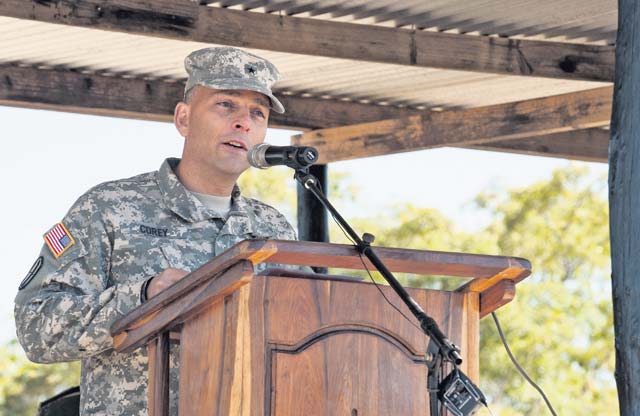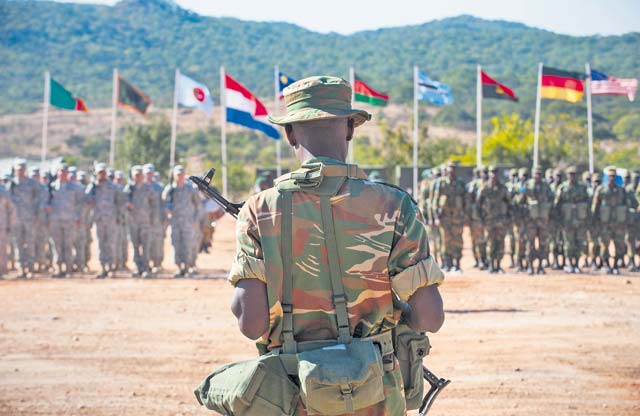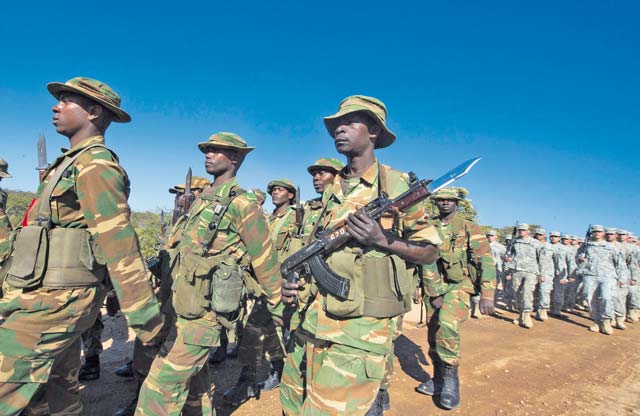
U.S. Army Brig. Gen. Peter Corey, deputy commander of U.S. Army Africa, speaks to a crowd during the opening day ceremony for exercise Southern Accord 15 Aug. 4 in Lusaka, Zambia.
LUSAKA, Zambia — U.S. and Zambian soldiers stood together in a battalion formation as both nations’ national anthems were played to signal the beginning of Southern Accord 2015 held in Lusaka, Zambia, Aug. 3 to 14.
Southern Accord 2015 brings together the U.S. Army, Zambian Defense Force, Southern African Development Community and other partner nation participants for two weeks of Command Post Exercise training and Field Training Exercises.
Brig. Gen. Peter Corey, deputy commander of U.S. Army Africa, Zambian army Commander Lt. Gen. Paul Mihova and Zambian Deputy Minister of Defense Christopher Mulenga welcomed more than 850 service members from several countries including Angola, Botswana, Germany, Malawi, Namibia, the Netherlands, Tanzania and the United Kingdom.
Southern Accord 2015 builds stronger partnerships between participating nations leading to an increased ability to work together and increasing their capacity to support peacekeeping operations, Corey said.
“The ultimate goal is increased cooperation between countries in the region and across Africa,” Mulenga said.
Training focuses on scenarios based on the U.N. Multidimensional Integrated Stabilization Mission in the Central African Republic where U.S.-trained Zambian Defense Force personnel are currently supporting peacekeeping operations.
Corey reminded all participants to work together and learn from each other during the exercise.
“Many of our African partners have a lot of experience with U.N. operations,” Corey said. “This is about partnering.”
Exercise participants used U.N. Security Resolution 2149 that initiated the MINUSCA to coordinate efforts during the exercise, said Capt. Scott Saunders, USARAF exercises deputy.
Each country’s military has its own doctrine that presents a challenge when trying to work together as a single military staff.
“We all have our own methods for problem solving,” Saunders said. “We need to speak a common language, and that’s where the U.N. doctrine comes in.”
“Most of the Americans have very little experience with U.N. operations,” Corey said. “We are learning together.”
The CPX helps validate the ability of a combined staff from partner nations to exercise command and control of a joint, combined force during peacekeeping operations.
The FTX training permits combined companies of U.S. and Zambian personnel to train together in both combined arms tactics and peacekeeping operations.
“The element of realism in the practical aspect of this training will present challenges,” Mulenga said.
“I commend the governments of partner nations, the United States Embassy Zambia, the Zambian service chiefs and all of you present here today for putting on this important event,” Mulenga said. “It is now my honor and privilege to declare Southern Accord 15 officially open.”









